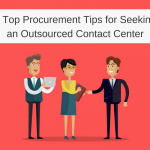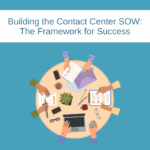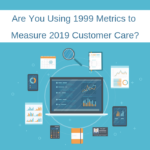The Fundamental Guide to the Contact Center RFP

Entering a new strategic partnership with a contact center outsourcer is one of the most significant decisions you make for your business. You’re putting your brand and your customers in the hands of a third-party who will have a direct impact on your business, its ROI, and all its related KPIs.
TL;DR: Whether you’re in procurement or are the VP of Customer Care, our RFP guide will provide you with helpful tips for outsourcing your customer service, from identifying key stakeholders to drafting the RFP.
It’s the type of decision that is often managed through a formal procurement/RFP process – and for good reason: this kind of KPI-driven, metric-driven partnership is well-suited in many ways to a structured procurement process. It can also be a challenge for procurement and executive teams to ensure that the process also supports true strategic partnership with long-term continual improvement and risk/reward models baked into the RFP as well.
If you’re the one in procurement, responsible for sourcing a customer care partner for the first time, or perhaps for the first time in a long time, this is the guide for you. If, on the other hand, you’re the VP of Customer Care or Customer Experience, this guide can help you achieve alignment between your vision and the tightly-organized process your procurement team will run. And it doesn’t have to be a painful process. Keep reading.
p.s. We packaged up some essential RFP questions in a customizable Excel template. Grab your copy here.
1. Identify Key Stakeholders
Regardless of who is quarterbacking the RFP – the procurement team or the customer care team – stakeholder involvement is essential. Who is going to be most impacted by the final decision? Who will be engaged with the outsourced team on a regular basis? For example, in many eComm organizations, the contact center team ends up working hand in hand with both marketing and fulfillment teams, but often – the stakeholders from those functional areas aren’t brought in at the front end of the process. Which leaders do you need to engage from the get-go? Although you want to avoid having too many cooks in the kitchen, collaboration is key.
2. Define Success Before You Begin
Start with the end in mind. What does success look like? What are potential deal breakers? How will a new partner impact your business objectives, and how will you measure their success? And obviously, pricing matters. With the clear success measures, deal-breaking criteria, and budget parameters in place – you can begin developing your process for evaluation and scoring of RFP responses.
3. Shortlist Your RFP Participants
What companies are you inviting to participate in your RFP process? There are a couple of considerations here.
First, if you have the luxury of time, an RFI process that precedes the RFP will be highly valuable. Sending out a Request for Information to a broader pool of vendors allows you to solidify the basics, narrow the list of contenders, and proceed to the RFP process more confidently.
If time is of the essence but you do have the luxury of a larger budget, hiring a consultant to narrow down a list of participants is also a valuable tactic. They can build a pool of preliminary vendors that appear to match your basic requirements. Once that list is assembled, you have the option to engage the consultant for rest of the process – or take the list they scrubbed and run with it yourself.
Finally, Google is the obvious “free” starting point – check out customer care solutions providers’ online presence and assess their websites for culture fit, suite of services and solutions, and self-reported strengths. This is where that deal-breaker list comes in handy. Are you looking for nearshore only, onshore only, or would you consider some offshore support in the mix? Do you require brick and mortar facilities for security purposes or are you looking for at-home strategies to support extreme peaks and valleys? What are your languages requirements? Do you need specific demonstrated capability in a specific field like FinTech, for instance? Is there evidence of best-in-class solutions as validated by third-party organizations like JD Power on the site?
Ultimately, the list you procure will determine how successful your RFP process is. Be careful about inviting too many companies to participate – if the pool is too crowded, you have your work cut out for you, and you’ll need to invest more time than you have or than is necessary, making the decision all the more difficult. On the flip side, too few participants may not accurately represent what the market has to offer.
4. Draft Your Contact Center RFP
Tempted to use a generic RFP template and bypass the headache of writing a new one? Don’t do it! Your RFP questions need to reflect the industry you’re focused on in order to get the most accurate view of your potential partners. If you need a head start, check out our exhaustive list of contact center RFP questions here.
This area is where collaboration with your stakeholders is essential. They will each have specific questions they want answered that will impact how they evaluate vendors; just make sure you streamline any questions that get repetitive. We see this all the time – several stakeholders end up getting the procurement team to ask several versions of the same question. This ends up being counterproductive as bidders either look for ways to answer the same question in slightly different ways or the evaluation team ends multiple answers that say: See above or Refer to our answer in Section 2.1.1. Look for ways to combine the nuances that each stakeholder is getting at into one question. For example, one might ask bidders to: Outline your quality assurance process and QA targets. While another stakeholder wants the RFP team to ask: Do you have dedicated Quality Assurance personnel? And yet another might ask: How often are quality monitors conducted and who conducts them? All three of those answers will have overlap. The three questions could be reconstructed to say: Describe your quality assurance process including the team structure, roles and responsibilities, frequency of monitors, and average QA targets for a program similar in nature to the one described in this RFP.
Also consider how your questions are phrased and whether they’re open-ended or require a yes/no or multiple-choice answer. Open ended questions are great, but if you’re short on time for the evaluation process, make sure you provide a stated page limit (and font size!) – otherwise you’ll be faced with a 150-page long RFP response when one half the length would have sufficed. Trust us. The bidders sales team wants all the freedom in the world to tell their story with pictures and charts. True confessions: we have submitted proposals in excess of 250 pages. And when required, we have boiled that down to 25 pages. Neither of those extremes is great – but it illustrates the point.
5. Format Matters
There are pros and cons to the tools you use to structure the actual RFP. Word documents are great for lots of open-ended questions where you can really get a sense of a contact center’s communication style. If you want to really dig into culture, employee engagement, training and onboarding, and company history are great examples where Word is a great option – you can allow your bidders to include photos/charts/examples of training content, etc.
On the other hand, if an apples-to-apples assessment of KPIs, metrics, statistics is your priority, an Excel-style spreadsheet is a great way to organize – and later compare – questions and answers.
Outside of those options, you may already have – or be considering – centralized procurement software. Tools like these may be enormously helpful in streamlining and comparing information. However, be aware of how these technologies impact the vendor response structure. Ensuring culture alignment between you and your contact center is critical, but discovering that alignment may require a more creative line of questioning than your procurement tool allows. If you do choose procurement software, allowing vendors to attach additional documents that can showcase any “out of the box” information is a good idea and a bad idea… you don’t want to create a nightmare of appendices for the evaluation team to wade through. Striking a balance is key.
6. The Timelines Will Affect the Quality of Your Responses and the Success of Your Launch
First, you’re going to need to reverse engineer this:
- When do you need your outsourced partner to go-live?
- Now back that up 12 weeks – that’s the date you need to have a Statement of Work signed by. Rushing through the implementation phase is in no one’s best interest. Allow 12 weeks and you’ll be setting yourself up for success.
- From the signed contract date – back it up again, how long does it typically take your organization to negotiate multi-million dollar contracts? Allow your legal and executive teams enough time to get through a reasonable negotiation.
- From that start of negotiation date, back up to: how long will your evaluation team need to review all the submissions, conduct site visits of the top three, and make a final determination?
- From the start of that assessment period, you now have the deadline for your RFP responses.
- From the deadline, we recommend you allow at least four weeks to distribute the RFP, gather vendor questions, answer vendor questions, and receive final submissions. The critical points to consider are: your respondents need time to review and submit questions. Your team needs time to review the questions, source the answers, and respond to the bidders with the answers. It is at that moment – when they receive the answers to their questions – that the bidding teams are going to start working on your customized response in full. This is vitally important for you and your procurement team to understand. You can count on bidders to ask smart questions that are going to inform their solutions in a way that is very specific to your needs. They can’t build their solution out fully until they have all the information including the specific answers to the specific questions they asked. So please, for the love of all that is good and merciful, give your bidders time to work out their solution AFTER you responded to their questions. At least a week. Ten days is better.
7. Evaluate RFP Responses
Company stakeholders and the procurement team should work collaboratively to score and evaluate RFP responses. Identify any deal-breakers as well as the differentiators and strengths of each individual vendor. RFP response evaluation can be difficult; it’s rarely an apples-to-apples comparison, even on hard numbers like pricing or metrics. Establishing some kind of quantitative scoring to measure qualitative answers seems counterintuitive but it’s necessary – at least as the first step – in order to make sure everyone is on the same page in the evaluation process. Sometimes you’ll have a clear winner; other times you may have to work by process of elimination until you’re confident in your decision. Building in the site visit is a critical piece of the process. On paper, all things can be equal, but for your primary stakeholders, it can come down to “who do you think you can work with most effectively?” And that is almost impossible to know without rolling up your sleeves together or sitting down and having a face-to-face dialogue. We learned from one procurement process that the client’s eval team sat down after their tours of the short-listed bidders’ sites and asked themselves, “Who would you want to work for if you were an agent?” We thought that was a great way to narrow it down to one final winner. (And we were super happy that their unanimous answer was Blue Ocean.)
Putting Together Your Contact Center RFP
On paper, it sounds straightforward, but we know better than anyone how complex the contact center RFP process can get. So we want to make it as easy for you as possible. Hopefully this guide helps a little, but we’d love to share more insight, so don’t hesitate to reach out today.
OR simply grab your RFP Template here – it’s customizable!
Check Out These Related Articles
4 Essential Resources to Read Before Your Craft Your Contact Center RFP
5 Insights About Sourcing and Developing Strategic Partnerships
Is It Time to Outsource? 5 Questions to Ask Yourself

![What You Need to Know When Looking for a New Contact Center Outsourcer [Slideshare]](https://blueocean.ca/wp-content/uploads/2017/07/What-You-Need-to-Know-When-Looking-for-a-New-Contact-Center-Outsourcer-150x150.png)

